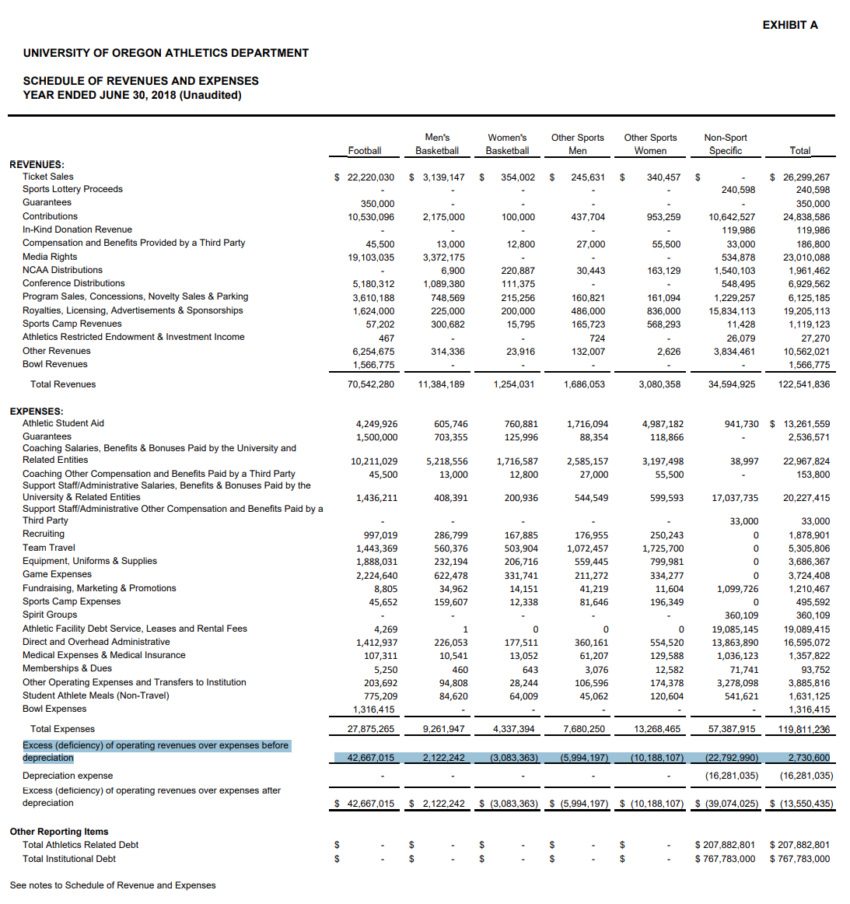Presumably Dana Altman’s metrics will be less positive this year, and Kelly Graves’s less negative. Before depreciation, from the “NCAA Agreed Upon Procedures Report for the year ended June 30, 2018 “, here.
These numbers show AD Rob Mullens running an operating profit of $2.7M last year, but they don’t include ~$5M in annual costs that the Ducks have foisted off on the academic side over the years, as explained in this post from 2017:
ODE reporter Kenny Jacoby is back from a summer internship at NBC TV in San Diego, and he’s wasting no time getting to work. Today the Emerald has the most comprehensive accounting I’ve seen yet of the ~$5M a year in subsidies that UO’s academic side pays to Rob Mullens and the Ducks:
It’s the beginning of another school year, which means another round of tuition hikes for UO students. The damage this year is a 6.6 percent increase for in-state students (about $810 per year) and a 3 percent increase for out-of-state (about $945). It was nearly 10.6 percent for in-state students, but a last-minute influx of state support helped mitigate the increase. Tuition has gone up for the fourth straight year and roughly doubled in the past decade.
The Oregon athletic department, meanwhile, continues to thrive. According to its projected 2018 budget, it expects to make $113 million in revenue, up from $110 million last year and $40 million a decade ago. Each year, however, it spends every dollar it brings in. It recently paid to buy former football coach Mark Helfrich and his coaching staff out of their contracts and hire Willie Taggart and 12 new assistant and strength coaches.
Of the $113 million in revenue in 2018, about $5 million will come directly out of UO students’ pockets. Students, through tuition and fees, foot the bill for tutoring and advising services for student-athletes, President Michael Schill’s luxury seats at Autzen Stadium and Matthew Knight Arena, student tickets to football and basketball games and debt service on the basketball arena and parking garage.
Over the summer, the Emerald asked Schill whether he would consider pulling any money from the athletic department budget to mitigate a tuition increase for students. The answer was a resounding no. He said athletics is going through its own budget issues, and that he is “comfortable” with the the current level of subsidy.
Some big ticket subsidies from Jacoby’s story:
Jaqua Academic Center – $2 million
UO students pay roughly $2 million per year on tutoring and advising services available exclusively to UO’s approximately 450 student-athletes, financial transparency reports show. By comparison, UO spends about the same amount each year on the Teaching and Learning Center in the fourth of the library or basement of PLC, which offers free group tutoring services and paid one-on-one sessions to 20,000 undergraduates.
Matthew Knight Arena – $502,000
The most expensive on-campus basketball arena in the U.S. costs UO students roughly $502,000 a year in debt service, plus the cost of using the arena for school events. A decade ago, when Knight pledged $100 million to build the $227 million arena, the athletic department scrambled to find funds to buy the land on which to build it, which at the time was owned by a bakery plant. So in 2009, then-athletic director Pat Kilkenny made a deal with then-President Dave Frohnmayer that ultimately left UO students paying roughly a quarter of of the $1.8-million-a-year land debt payment. …
In addition to land debt service, UO students also pay money to use Matthew Knight Arena. Financial records obtained by the Emerald show UO has paid athletics more than $230,000 in the past three years on expenses on 27 school events at Matthew Knight Arena, including rent, audio/video technology, janitors, ushers and changeover (changing the venue from a basketball facility to accommodate different types of events). Using Matthew Knight Arena for Ta-Nehisi Coates’ lecture in February, for example, cost UO nearly $40,000 — not including the $41,000 in donor money it paid to Coates.
Student Tickets – $1.7 million
UO students pay athletics nearly $1.7 million a year in student fees for tickets to UO sporting events.
President Schill’s Luxury Seats – $412,000
As part of the 2009 agreement between Frohnmayer and Kilkenny, UO agreed to pay the athletic department $375,000 a year for use of the presidential suite, 80 club level season tickets, eight reserved season tickets and 11 parking spaces at Autzen Stadium. UO also agreed to pay for 20 men’s basketball season tickets and four garage parking passes at Matthew Knight Arena, which amounted to $32,456 last year. The seats are used “for donor engagement and fundraising activities,” according to athletic department spokesman Craig Pintens.
Parking Garage and Parking Revenue – $625,000
Also part of the 2009 agreement, UO agreed to finance a portion of the debt service on the underground parking garage at Matthew Knight Arena and allow athletics to keep the parking revenue generated during games, as well as outside events managed by athletics, such as concerts. This amounts to $521,000 a year for debt service and between $250,000 and $270,000 in lost revenue — minus roughly $150,000 that the athletic department pays the City of Eugene for parking enforcement — during Matthew Knight Arena events.
:

If the luxury seats are used for fundraising and are a worthwhile expense for that reason, the UO Foundation should be willing to make that investment.